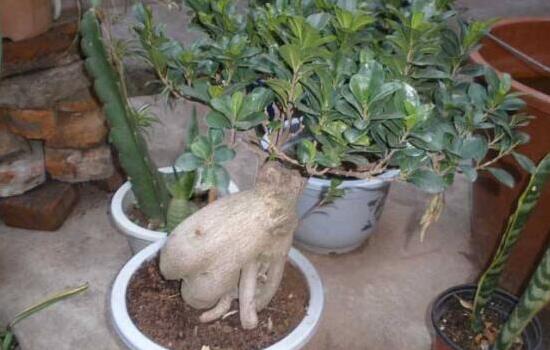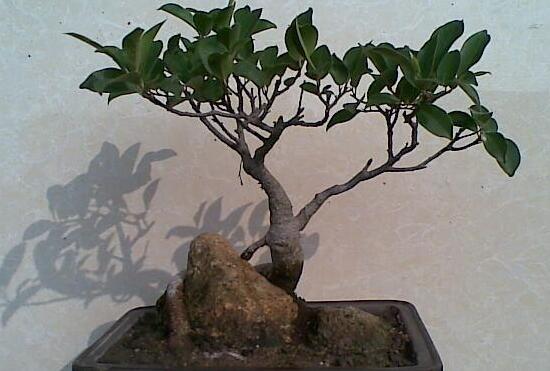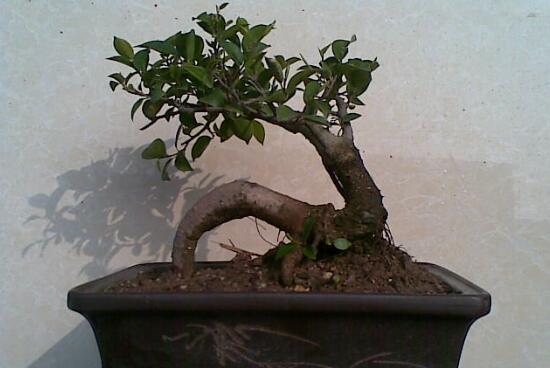How to make ginseng banyan root expand, ginseng banyan root hypertrophy method / sowing is the key
As an ornamental plant, ginseng banyan is kept at home by many flower friends. The beauty of ginseng banyan is mainly reflected in its developed roots. It is really interesting to look at the roots that reveal the soil layer that looks like ginseng. In order to make the ginseng banyan look more interesting, many flower lovers want its roots to be bigger, so how to make the ginseng banyan roots expand? The following is how ginseng banyan makes its roots fat. Follow the editor to learn.
First, how to make ginseng banyan root expand, sowing is the key

The value of ginseng banyan lies in the shape of the root. As shown in the picture above, the root of ginseng banyan is very much like ginseng, so it is also the best plant to celebrate longevity. In order to reflect the root of ginseng banyan, many flower lovers want to make its root bigger, so how to make ginseng banyan root expand? Strong flower friends are omnipotent, they sum up the following skills, of which sowing is the key, as long as we do it, we can make the roots of ginseng banyan bigger!
2. The method of making root hypertrophy of ginseng and banyan.
1. Large space for growth
If you want the root of ginseng banyan to expand, there is a fundamental condition, that is, it must have enough space to grow. In this regard, we can choose to grow outdoors, after all, the outside is not only a wide space, sunshine, ventilation are very good. Of course, most of the flowers are planted indoors, so they can't be planted directly in the soil, but we can choose tall pots to grow them.
2. Suitable soil
How to make ginseng banyan root swell? In addition to space, soil can be said to be critical. In this regard, flower friends can choose ginseng banyan favorite soil: sand, river sand mixed culture soil. In order to make the roots of ginseng banyan grow thicker and bigger, it is best to add some potash fertilizer to the soil.
3. Planting by sowing
There are many propagation methods of ginseng banyan, but if you want ginseng banyan root to expand, it is best to use ginseng banyan seed to sow seeds. The reason for this is that the roots of ginseng banyan sown with seeds are thicker. Although cutting propagation is fast and striping propagation is convenient, the roots of ginseng and banyan growing up are not as large as those sown and propagated.
4. All the roots are buried in the soil
How to make ginseng banyan root swell? There is a very simple method, that is to bury all the roots of ginseng banyan in the soil, so that it can fully absorb nutrients and water, and grow naturally and quickly.
5. Pruning and pruning
There is one thing that is easy for everyone to use to make the roots of ginseng banyan fat, that is, pruning and leaf pruning at the right time. The total amount of fertilizer given to the plant remains the same, and if you want the root to expand, you have to absorb more nutrients, which can be solved by reducing the number of branches and leaves. Generally speaking, it is best to keep ginseng banyan leaves no more than 5 and branches no more than 10 centimeters.
How to raise ginseng banyan? Detailed introduction of culture methods of ginseng banyan
[introduction to ginseng banyan] Ginseng banyan, which looks like a ginseng plant, certainly cannot be eaten like ginseng. It is actually cultivated from a banyan tree, but it is much smaller than a banyan tree, and each ginseng banyan is only about 15 to 20 centimeters long. Ginseng banyan is very popular in recent years because it looks like ginseng, which means longevity. The expanded root at its base is actually formed by the mutation of the radicle and Hypocotyl during seed germination. Some plants also grafted banyan or egg-leaf banyan (a variety of fine-leaf banyan) at the base of its stem, which is more elegant. When cultivating ginseng banyan, if you can choose a pot full of ancient interest, it will certainly add to the elegant charm of ginseng banyan. Ginseng banyan, like the banyan tree, is an extremely strong plant, as an indoor decoration or a small gift to others, is also a good choice. Ginseng banyan likes the environment with high temperature and plenty of sunshine, so it is best to put it in a place where it can be exposed to the sun.
[culture method of ginseng banyan]
Temperature: the requirements of light, heat, water and fertilizer of ginseng banyan are the same as those of Ficus mandshurica. They prefer warm, humid and sunny environment, and are not cold-resistant and semi-shade-tolerant. The suitable temperature for growth is 20 ℃ to 30 ℃. The temperature in the greenhouse should be maintained at no less than 5 ℃ in winter.
Soil: it is best to cultivate with river sand or sand. In order to make the roots of ginseng banyan big and fat, a little fertilizer should be added, which can be added with a higher proportion of phosphorus and potash fertilizer. When cultivating ginseng banyan, be sure to use seeds to sow seeds in order to grow fat roots.
Change the basin: ginseng banyan bonsai, can be changed every 2 years, the best time is before leaving the house in spring. First pick out the soil around the flowerpot, then gently take out the huge root tuber plants, mash off part of the persistent soil, cut off some lifeless aging roots, and re-choose fresh, fertile, loose drainage and nutrient-rich culture soil to plant well. As the plant grows, larger flowerpots can be replaced to meet the needs of its normal growth. At the same time of changing the basin, the branches and leaves should be trimmed and adjusted appropriately so that they can continue to maintain a good plant shape. Watering should not be excessive when just changing soil, and then normal water and fertilizer management should be given when the temperature rises to more than 20 ℃.
Ginseng banyan bonsai cultivation soil: the banyan tree is strong in nature and the selectivity of cultivated soil is not strict. If possible, sandy soil can be used to mix coal cinder. Unconditional general flower soil can also be used. The finished product can also use the substrate coconut bran as the cultivation soil. The cultivated soil is required to be loose and fertile sandy loam with good drainage rich in organic matter and acidic reaction. Alkaline soil can easily lead to leaf yellowing and poor growth.
Watering: water for the root of ginseng and banyan bonsai. When the root matrix (coconut bran or soil) is nearly dry, pour the water thoroughly at one time. Then wait for a period of time to dry before watering. It usually needs to be watered five times a day. Water can be watered more often in summer, depending on the situation. Ginseng and banyan bonsai leaves use water. The leaves can often be sprayed with a small amount of water (foggy water). During the growth period, it is required that the water supply should be sufficient, it should be wet rather than dry, and the basin soil should always be kept moist. During the period of branching and sending leaves, watering should be properly controlled, or more spraying and less watering can make the leaves short and thick, and give sufficient light at the same time. Make the leaves thick and bright.
Fertilization: fertilization management of ginseng and banyan bonsai. The banyan tree does not like fertilizer, and a small amount of compound fertilizer (slow-release fertilizer) can be applied once every season. The main composition of fertilizer is nitrogen, phosphorus and potassium. Fertilizing 3 to 4 times a year should not be excessive, otherwise it is easy to cause the branches and leaves to grow and destroy the composition and shape of the plant.
Pest control: its leaves are often susceptible to leaf spot disease, which can be sprayed with 800 times of 70% methyl topiramate wettable powder, and a small number of diseased leaves can be removed and destroyed as soon as possible to prevent it from spreading.
Lighting: it should be noted that during the growth period, the potted soil should not be too wet, let alone insufficient light, otherwise it will cause a large number of fallen leaves and affect the display and viewing.
How to raise ginseng and banyan bonsai methods of pot culture of ginseng and banyan
Ginseng banyan tree is given the meaning of longevity and auspiciousness, symbolizing splendor and wealth, so it is the best gift for birthday. It is widely planted and is only used as a variety of potted plants, placed in courtyards, halls, terraces, corridors and other places to beautify the environment. Today, I will briefly introduce how to raise the bonsai of ginseng and banyan trees and the breeding methods of ginseng and banyan trees.
Introduction of ginseng and banyan tree
Ginseng banyan, Latin name Ficus microcarpa. Moraceae, evergreen trees, banyan stump bonsai. As the banyan root system is developed, the root is often raised, and protruding from the ground, because her root block shape is unique, so that consumers have a special preference. China is distributed in Guangxi, Guangdong, Hainan, Fujian, Yunnan and Guizhou. There are also cultivation in India, Myanmar and Malaysia. Plants growing in tropical and subtropical regions. It is famous for its "single tree into a forest", which is produced in Shaxi banyan tree in Fujian province.
The root of ginseng banyan tree is similar to ginseng, with natural shape, exposed root plate, luxuriant crown, unique charm, interesting and pleasant mood, and is deeply loved by flower friends all over the world. In the Netherlands, ginseng banyan tree has been named "China roots". It can be said that it has become a flower variety with Chinese brand in the world.
1. Morphological characteristics
Ginseng banyan is cultivated from the seedlings of Ficus microcarpa. The expanded root at its base is actually formed by the mutation of the radicle and Hypocotyl during seed germination. Some plants also grafted F.deltoidea or egg-leaf banyan (a variety of fine-leaf banyan) at the base of its stem, which is more elegant. Ginseng banyan belongs to shrubs or small trees of Moraceae. Its roots are like ginseng and small banyan trees. The shape of the trunk is very similar to the shape of a man who is watching, so it is called "ginseng banyan". Also known as banyan melon, sweet potato banyan.
Ginseng banyan root is similar to ginseng, with natural shape, exposed root plate, luxuriant crown, unique charm, interesting and pleasant mood, and is deeply loved by consumers all over the world. In the Netherlands, it has been named "China roots" (Chinese Root). It is a flower variety with Chinese brand and going to the world. It is a beautiful scenery decorated inside and outside the house.
Second, growth habits
The growth temperature is 18-33 degrees, not less than 10 degrees in winter, and it is easy to suffer frost damage if it is lower than 6 degrees. Sex likes a warm and humid environment. It can be placed in places with proper light in spring and autumn and in places without direct sunlight in summer. Ginseng banyan watering should be dry and wet, and the basin soil should always be kept moist.
# FormatImgID_2#
Methods of pot culture of ginseng and banyan trees
1. Soil requirements:
Ginseng banyan tree is strong by nature, and the requirement of growth substrate is not very strict. Conditional use of sandy soil and coal slag mixed preparation, unconditional use of general flower soil is also OK. The substrate coconut bran can also be used as cultivation soil for adult ginseng banyan trees. Generally, the sandy loam with loose and fertile soil, good drainage, rich in organic matter and acidic reaction is the best. Alkaline soil is easy to lead to leaf yellowing and poor growth.
2. How to change the basin:
The basin can be changed every 2 years, and the best time is before leaving the house in spring. First pick out the soil around the flowerpot, and then gently take out the huge root tuber plants, mash part of the persistent soil, cut off some lifeless aging roots, and re-choose fresh, fertile, loose drainage, nutrient-rich culture soil to plant well. As the plant grows, a larger flowerpot can be changed to meet the needs of its normal growth. When changing the basin, the branches and leaves can be trimmed and adjusted appropriately so that they can continue to maintain a good plant shape.
3. Fertilization management:
Ginseng and banyan trees do not like fertilizer and can apply a small amount of compound fertilizer (slow-release fertilizer) every season. The main components of fertilizer are nitrogen, phosphorus and potassium. The number of fertilization is 3-4 times a year, which should not be excessive, otherwise it is easy to cause the branches and leaves to grow and destroy the composition and shape of the plant. Ginseng and banyan trees are not resistant to cold and semi-shade, and the suitable temperature for growth is 20 ℃-30 ℃. The temperature in the greenhouse should be kept at least 5 ℃ in winter, otherwise it will be affected by freezing injury.
4. Watering method:
Watering ginseng and banyan trees should be dry and wet, basin soil should always be kept moist, and should be placed in a shady place in summer. Fertilization depends on the growth trend, the general growth season can be a month or so every year to apply fully mature thin bean cake water, vegetable cake water, rice sugar water and so on. Prevent cold in winter, prevent sun exposure in summer, and pay attention to disinfestation and disease control all the year round. When cultivating ginseng and banyan trees, be sure to use seeds to sow seeds in order to grow fat roots.
Matters needing attention in the culture of ginseng and banyan trees
If the newly bought ginseng banyan tree has lost its leaves, there is no need to worry, because the newly bought ginseng banyan tree needs to adapt to the new environment, so it is normal to lose its leaves at the beginning. After buying the ginseng and banyan tree, you can first take the basin (the process of adapting to the new environment, maintaining in the astigmatism, do not bask in the sun), and then consider the management methods such as sun exposure and fertilization.
Do not move the position at will, after choosing the location, in addition to watering, occasionally take care of, do not take care of three times a day. Should pay attention to ventilation, because ginseng banyan half-overcast, some flower friends will choose to raise indoors, which leads to poor indoor air circulation, resulting in the lack of vitality of ginseng banyan. Pay attention to pruning, if it is not trimmed for a long time, it will have no ornamental value.
- Prev

How long does ginseng banyan fertilize and how long water? How to fertilize and propagate ginseng banyan? what about the yellowing leaves?
Ginseng banyan, named for its long roots like ginseng, is an ornamental plant suitable for indoor culture. It can be said that it is very simple to feed ginseng banyan, but it is not easy to want the beauty of ginseng banyan growth, especially watering and fertilizing.
- Next

How to trim the bonsai of ginseng banyan, the pruning method of ginseng banyan / 3 tricks to cut out the perfect shape
Ginseng banyan, named because the root of the soil is shaped like ginseng, is a kind of plant that flower friends prefer to raise. However, if you want the bonsai of ginseng and banyan to be beautiful and more enjoyable, in addition to daily water, fertilizer and light management, timely pruning is very important. So, how to trim the ginseng banyan bonsai?
Related
- Fuxing push coffee new agricultural production and marketing class: lack of small-scale processing plants
- Jujube rice field leisure farm deep ploughing Yilan for five years to create a space for organic food and play
- Nongyu Farm-A trial of organic papaya for brave women with advanced technology
- Four points for attention in the prevention and control of diseases and insect pests of edible fungi
- How to add nutrient solution to Edible Fungi
- Is there any good way to control edible fungus mites?
- Open Inoculation Technology of Edible Fungi
- Is there any clever way to use fertilizer for edible fungus in winter?
- What agents are used to kill the pathogens of edible fungi in the mushroom shed?
- Rapid drying of Edible Fungi

